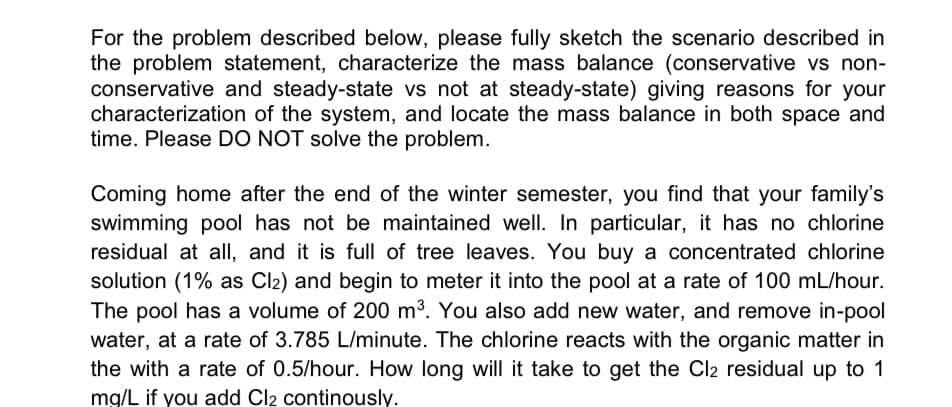University Physics Volume 1
18th Edition
ISBN:9781938168277
Author:William Moebs, Samuel J. Ling, Jeff Sanny
Publisher:William Moebs, Samuel J. Ling, Jeff Sanny
Chapter15: Oscillations
Section: Chapter Questions
Problem 71CP: Consider the van der Waals potential U(r)=U0[( R 0 r)122( R 0 r)6] , used to model the potential...
Related questions
Question

Transcribed Image Text:For the problem described below, please fully sketch the scenario described in
the problem statement, characterize the mass balance (conservative vs non-
conservative and steady-state vs not at steady-state) giving reasons for your
characterization of the system, and locate the mass balance in both space and
time. Please DO NOT solve the problem.
Coming home after the end of the winter semester, you find that your family's
swimming pool has not be maintained well. In particular, it has no chlorine
residual at all, and it is full of tree leaves. You buy a concentrated chlorine
solution (1% as Cl₂) and begin to meter it into the pool at a rate of 100 mL/hour.
The pool has a volume of 200 m³. You also add new water, and remove in-pool
water, at a rate of 3.785 L/minute. The chlorine reacts with the organic matter in
the with a rate of 0.5/hour. How long will it take to get the Cl2 residual up to 1
mg/L if you add Cl2 continously.
Expert Solution
This question has been solved!
Explore an expertly crafted, step-by-step solution for a thorough understanding of key concepts.
Step by step
Solved in 2 steps

Knowledge Booster
Learn more about
Need a deep-dive on the concept behind this application? Look no further. Learn more about this topic, physics and related others by exploring similar questions and additional content below.Recommended textbooks for you

University Physics Volume 1
Physics
ISBN:
9781938168277
Author:
William Moebs, Samuel J. Ling, Jeff Sanny
Publisher:
OpenStax - Rice University

Classical Dynamics of Particles and Systems
Physics
ISBN:
9780534408961
Author:
Stephen T. Thornton, Jerry B. Marion
Publisher:
Cengage Learning

University Physics Volume 3
Physics
ISBN:
9781938168185
Author:
William Moebs, Jeff Sanny
Publisher:
OpenStax

University Physics Volume 1
Physics
ISBN:
9781938168277
Author:
William Moebs, Samuel J. Ling, Jeff Sanny
Publisher:
OpenStax - Rice University

Classical Dynamics of Particles and Systems
Physics
ISBN:
9780534408961
Author:
Stephen T. Thornton, Jerry B. Marion
Publisher:
Cengage Learning

University Physics Volume 3
Physics
ISBN:
9781938168185
Author:
William Moebs, Jeff Sanny
Publisher:
OpenStax